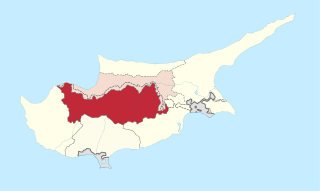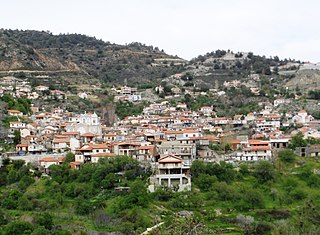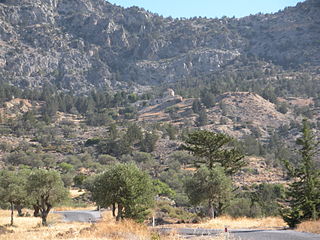Related Research Articles
Leontios Machairas or Makhairas was a historian in medieval Cyprus.

Kyrenia District is one of the six districts of Cyprus. Its main town is Kyrenia. It is the smallest of Cyprus' districts, and is the only one controlled in its entirety by the unrecognised de facto state of Northern Cyprus, where the same territory is administered as the de facto Girne District, a distinct entity.

Nicosia District is one of the six districts of Cyprus. Its main town is the island country's capital city, Nicosia. The de-facto TRNC-controlled northern part of the district is the Lefkoşa District of the unrecognized Turkish Republic of Northern Cyprus.

Selimiye Mosque, historically known as Cathedral of Saint Sophia or Ayasofya Mosque, is a former Christian cathedral converted into a mosque, located in North Nicosia. It has historically been the main mosque on the island of Cyprus. The Selimiye Mosque is housed in the largest and oldest surviving Gothic church in Cyprus possibly constructed on the site of an earlier Byzantine church.
Guy of Ibelin (1286–1308), Lord of Nicosia, was the son of Balian of Ibelin, seneschal of the kingdom of Cyprus, and of Alice of Lampron.
Stefano Lusignan (1537–1590), also known as Étienne de Lusignan and Estienne de Lusignan, was a priest, scholar, and titular bishop of Venetian Cyprus who migrated to Italy and France.

Guy of Ibelin was seneschal of Cyprus from 1318 and a burgher of Venice from 30 December 1334. He was the son of Philip of Ibelin (1253–1318), previous seneschal of Cyprus and Jerusalem by his second wife Maria Embriaco of Giblet. He was evidently held in high regard by King Hugh IV of Cyprus, since he is named in a royal decree from 1329 as a "magnificus vir" , in charge of four newly created priesthoods in the cathedral of Nicosia.

Arediou is a village located in the Nicosia District of Cyprus. A developing village which has the advantage of "Arediou intercity Bus Station" connecting the province villages with the suburbs of Nicosia.

Moniatis is a village in the Limassol District of Cyprus, located 5 km southeast of Pano Platres. The villagers claim that it was named after its numerous "mantres" (sheepfold). Its 100 to 110-strong Turkish Cypriot population was displaced as a result of the intercommunal violence in 1963, during which they fled the village to Limassol, and the Turkish invasion of Cyprus in 1974, after which they were transferred to the north.

Pelendri is a village in the Limassol District of Cyprus.

Panagia Apsinthiotissa or Absinthiotissa is a Greek Orthodox monastery located at the southern foot of the Pentadaktylos range in the Republic of Cyprus. The nearest settlements are Sychari and Vouno. The site presently falls within the de facto Turkish Republic of Northern Cyprus in Girne District.
Neophytos of Cyprus, Saint Neophytos, Neophytos the Recluse was a Cypriot Orthodox monk, priest, and sometime hermit, whose writings preserved a history of the early crusades. "He is considered to be one of the most significant figures of the Church of Cyprus"

The island of Cyprus was an overseas possession of the Republic of Venice from 1489, when the independent Kingdom of Cyprus ended, until 1571, when the island was conquered by the Ottoman Empire.

The fortifications of Famagusta are a series of defensive walls and other fortifications which surround the city of Famagusta in Northern Cyprus. The walls were built by the Lusignan Kingdom of Cyprus in the 14th century, and redesigned by Republic of Venice in 15th and 16th centuries before the siege of Ottoman Empire in 1571. The fortifications of Famagusta withstood an 11-month siege before the city capitulated to the Ottoman Empire in August 1571.

Arnaude de Rocas is a legendary personality from Cyprus, remembered there as a martyr and a Cypriot heroine.
Georgios Boustronios was a 15th century Cypriot royal official and chronicler possibly of Syrian origin. His chronicle Διήγησις Kρόνικας Kύπρου was written in prose in Cypriot Greek. He was a close friend and serviceman of James II, the King of Cyprus. His chronicle documents events contemporary to his life, especially the transition from the Lusignan to the Venetian rule in Cyprus. His narrative starts where the chronicle of Leontios Machairas ends, at 1456, and concludes at 1489, the year when Catherine Cornaro, the last queen of Cyprus, ceded the island to the Republic of Venice. He documented the civil war between Charlotte and her half brother James II, between 1440 and 1444, and the interventions by Hospitallers and Mamluks in the politics of the island. He was a relative of Florio Bustron, a notary and the author of another chronicle on Cypriot history, titled Chronique de l'île de Chypre, that begins with antiquity and also ends in 1489.
The Cypriot Canzoniere (Song-book) οr the Cypriot Rime d'Amore is a collection of 16th century poems in the Cypriot dialect influenced by the Italian Renaissance poetry and especially Petrarchism. They were written by a one or more, anonymous Cypriot poets that were directly influenced by Italian poetry. The manuscript consists of 156 poems focusing mostly on love themes. Some of the poems are direct translations of Petrarch and Sannazaro. They are the first poems directly influenced by the Renaissance in the Greek language, for example they introduced the ottava and terza. The societal, cultural and musical norms in Venetian Cyprus are documented by the chronicler Etienne Lusignan and help shed light into the references of the poems.
The Chronicle of Amadi or simply Amadi is an anonymous chronicle written around 1520 in Italian prose with some Venetian traits. Its one of the major sources on the Frankish Kingdom of Cyprus under the Lusignan dinasty (1192-1489). The text details the history of Cyprus starting from the Byzantine Emperor Heraclius and his wars against the Sassanids for the recovery of the Holy Cross in the seventh century to the wedding of King John II with Helena Palaiologina on 3 February 1441, closely following the closing date of the 15th century Greek chronicle of Leontios Machairas. Additionally, it includes a short account of the history of the crusader Kingdom of Jerusalem from its foundation onwards. The codex contains Italian excerpts and translations of a number of narrative histories from the Latin East. These include William of Tyre’s Eracles, the Annales de Terre Sainte, Philip of Novara’s Estoire et le droit conte de la guerre qui fu entre l’empereur, and the anonymously authored Chronique d’un Templier de Tyr.
Kleides or Klides or Klidhes or Kleidhes, meaning keys in Greek, is a group of small rocky uninhabited islands at the north of Cyprus. Some ancient writers called them the "edge of Cyprus" . Strabo writes that the Kleides were two isles lying off Cyprus opposite the eastern parts of the island, which are seven hundred stadia distant from the Pyramos river. Pliny the Elder, writes that they were four islands. In reality the islets are six, but the three can considered more like rocks in the sea than islets. The islands are also mentioned by the Ptolemy in his work Geography, Herodotus in his work Histories and Hesychius of Alexandria in his lexicon. A poem in Greek Anthology is also mentioning the islands.
The martyrs of Kantara are thirteen Orthodox monks from the Kantara monastery in Cyprus, persecuted and executed in May 1231 at the request of Pope Gregory IX and under the direction of his emissary, Andrew. After an inquisition trial for refusing the use of unleavened bread for the Eucharist, they were imprisoned, tortured, and then burned alive. One of them died in prison before the execution.
References
- ↑ Coureas, Nicholas (2019-03-05). Chequered Fortunes: Foreign Soldiers on Cyprus under King James II (1460–1473) and Their Portrayal in the Cypriot Chronicles. Brill. ISBN 978-90-04-39207-6.
- ↑ Nicolaou-Konnari, Angel (2016-09-13). "Bustron, Florio". Encyclopedia of the Medieval Chronicle.
- 1 2 Polignosi. "Βουστρώνιος Φλώριος". www.polignosi.com. Retrieved 2024-02-18.
- ↑ Patapiou, Nasa; Lazarou, Chrystalleni (2013). "Hiromeri: A Specialty Ham of Cyprus—Historical Evidence, Culinary and Cultural Perspectives". Ecology of Food and Nutrition. 52 (3): 239–250. doi:10.1080/03670244.2012.706141. ISSN 0367-0244. PMID 23621488. S2CID 41298436.
- ↑ Beihammer, Alexander (2013-06-01). "The Kingdom of Cyprus and Muslim–Christian Diplomacy in the Age of Mehmed the Conqueror". Crusades. 12 (1): 197–232.
- ↑ Coureas, Nicholas; Andreas, Orphanides (2007). "Piracy in Cyprus and the Eastern Mediterranean during the Later Lusignan and Venetian Periods (15th-16th Centuries)". Eπετηρίδα του Κέντρου Επιστημονικών Ερευνών. XXXIII: 121–162.
- ↑ Papademas, P. (2006-07-19), Tamime, Adnan (ed.), "Halloumi Cheese", Brined Cheeses, Oxford, UK: Blackwell Science Ltd, pp. 117–138, doi:10.1002/9780470995860.ch4, ISBN 978-0-470-99586-0 , retrieved 2021-02-24